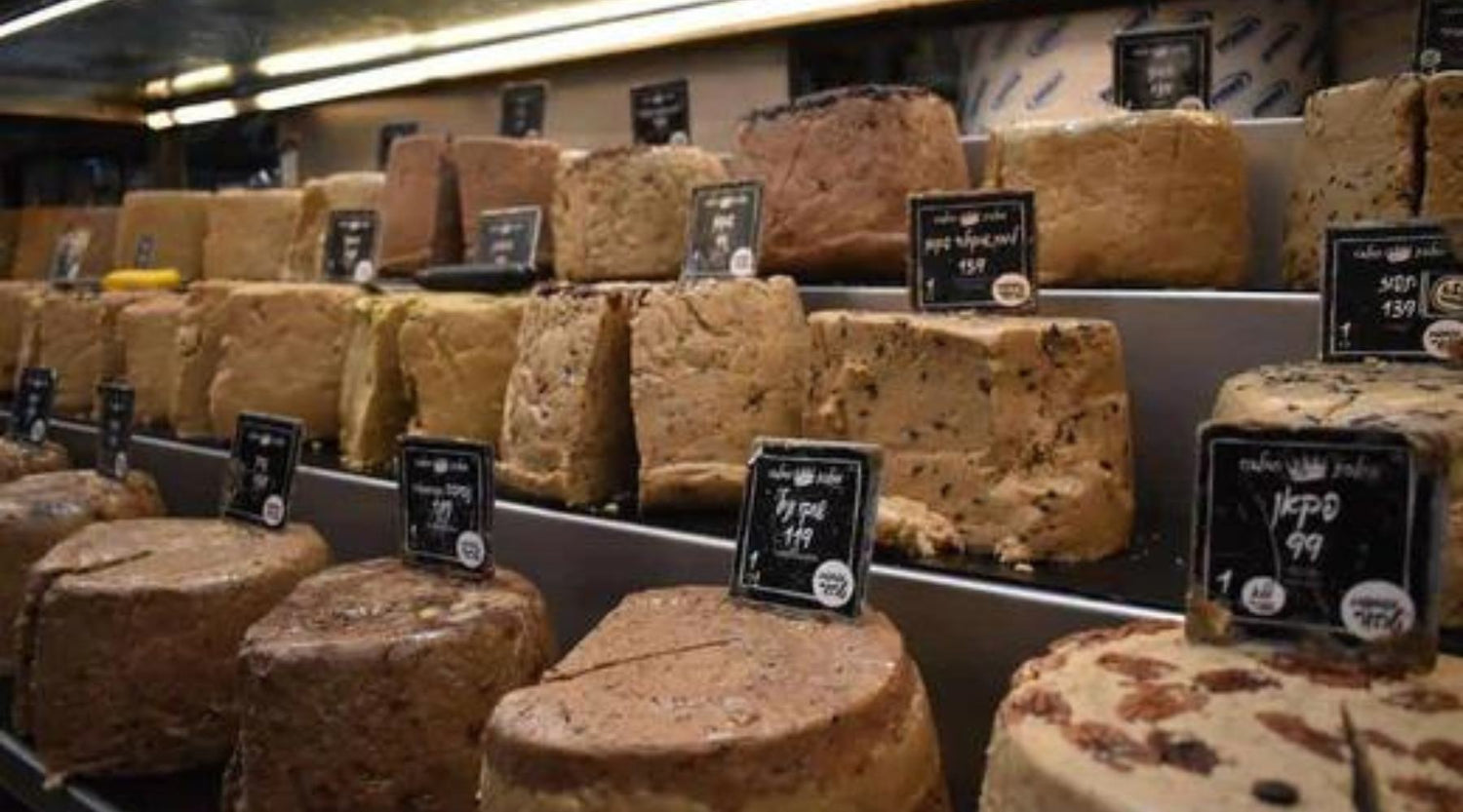For once, this recipe doesn't contain any chocolate, but it's still far too good to withhold from you! If you have ever traveled to Great Britain or a former English colony, you are probably already familiar with shortbread, these delicious, buttery cookies that go so well with afternoon tea. But in the long run, “normal” shortbread might get a bit boring. That's why we strongly advise you to bake this recipe! The sweetness and bitterness of the Middle Eastern ingredients halva and tahini used in it and the salty caramel layer complement the Scottish classic perfectly!
If you want to find out more about shortbread, please scroll to our FAQs at the end of the article!
What you need for this:
To fill a square tray with a side of about 20 cm with the delicious, layered tahini halva shortbread, you need the following ingredients:
For the shortbread:
- 40g powdered sugar
- 35g corn flour
- 40g sugar
- 175g butter (unsalted, melted but cooled to room temperature)
- 0.5 teaspoon vanilla extract
- 250 g flour
- 0.5 teaspoon salt
For the halva layer:
- 200 g halva, crumbled into coarse pieces
- 80g tahini
And for the tahini caramel:
- 200g sugar
- 120ml water
- 100g butter (cut into cubes and brought to room temperature)
- 80 ml cream
- 150g tahini
- 0.25 teaspoon sea salt flakes
Step 1: Bake the shortbread
- Start by preparing the shortbread layer. Preheat the oven to 200 °C, 180 °C fan/gas mark 6 and line the baking tin with baking paper. The baking paper may extend beyond the edges of the pan.
- Then sift the powdered sugar and cornmeal into the bowl, add the sugar and mix the whole thing either using a hand mixer or directly in a food processor.
- Slowly add the melted butter while stirring constantly and mix the ingredients until they have combined into a mixture. Add the vanilla extract and stir this into the mixture too. Then turn the mixing setting down a little and gradually sift in the flour and salt and continue stirring until the shortcrust pastry has come together well.
- You can then put the dough into the mold. Press it evenly into the pan with your hands and then bake on the middle rack for about 25 minutes, or until the shortbread has taken on a golden brown color. When the shortbread is finished baking, take it out of the oven and let it cool completely, i.e. at least an hour, before adding the other layers.
The topping: halva and tahini caramel
The halva layer is then very quick: simply mix the two ingredients, halva and tahini, with a wooden spoon and spread evenly over the cooled shortbread layer.
The caramel is a little more complicated:
- Place the sugar and water in a small pan and heat the mixture over low heat.
- Stir the whole thing every now and then. When the sugar has dissolved, increase the heat to medium-high and bring the mixture to a boil, maintaining the heat until the color is a deep golden brown.
- Then take the pan off the heat and add the cream and butter. Be careful as the hot sugar mixture may splatter. Stir the mixture well again and as soon as the butter has melted, add the tahini and salt. Stir well again, then you can add the tahini caramel to the halva layer of your shortbread and distribute it evenly.
- Before you cut the shortbread into small pieces, you should definitely let it rest in the refrigerator for at least 4 hours. The absolute highlight is if you sprinkle a little extra salt over the shortbread before serving!
This recipe also comes from the highly recommended book "Sweet" by Yotam Ottolenghi and the dessert expert Helen Goh.
FAQ about the tahini halva shortbread
For those who don't like Great Britain: A bit of shortbread history
Shortbread is a typical Scottish pastry that is common and popular throughout the United Kingdom. It is not known who originally invented the pastry. Some are convinced that shortbread was baked in Scotland as early as the 12th century. Other sources place its origin a hundred years later. Accordingly, the inventor of these special cookies was a baker at the court of Mary Stuart.
According to the second version, the infamous regent immediately fell in love with the buttery delicacy and shortbread became a popular snack at the Scottish court. The common people of Scotland baked the cookies in a slightly slimmed down version, with oats instead of flour and without sugar. Flour and sugar were expensive goods at that time and enjoyment of the original was therefore limited to special occasions.
Today you can find shortbread in probably every supermarket in Scotland and England. And in Germany you don't have to bake it yourself, you can easily buy it in many shops. Of course, the baked version from this recipe tops any supermarket shortbread. ;)
What is Halva/Tahini and where can I buy these ingredients?
Both are specialties that come from the Middle East. It's best to look for an Arabic delicatessen in your city, they usually have both ingredients in their range.
As the name suggests, our halva tahini brownies also use both ingredients. Plus, of course, our favorite baking ingredient: chocolate!
Is this also possible in vegan form?
Basically definitely! The only ingredients of animal origin in this recipe are the butter and cream. For a vegan version, simply replace the butter with margarine and the cream with a plant-based alternative such as oat or soy cream.
But keep in mind that the typical shortbread taste is heavily influenced by butter. The vegan version probably doesn't quite match the original in terms of taste. And be sure to use a high-quality margarine!



